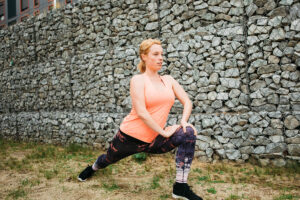Patellofemoral Pain Syndrome (PFPS) is a generic term ascribed to vague, and often-times fluctuating, anterior (front side) knee pain. PFPS affects athletes and non-athletes, alike, and can feel like a pretty severe knee ache, like a bruise. It often affects runners and cyclists, but can also affect people whose occupation or lifestyle requires repetitive movements like bending, climbing up and down stairs, sitting and standing repeatedly, or walking over uneven ground.
The onset of the pain is often sneaky, without warning, and progresses gradually with steadily inconsistent pain levels. It can happen without any obvious faulty movement with which to determine the cause of pain. The indeterminate nature of the injury is usually the most difficult to understand, mainly because the dysfunction is a result of repetitive micro-trauma caused by the same movement patterns, even when there was no pain initially.
Over the years, I have heard an old adage that I cannot trace back to a specific resource, but which most clearly reveals why we hurt. “It has been said that we move ‘funny’ because we ‘hurt’, but we really ‘hurt’ because we move ‘funny’.” In fact, in the instance of PFPS, the cause of the knee pain is usually related to poor hip and/or foot control, and the lack of control unfortunately exposes the knee to unmitigated micro-trauma and pain.
As you can see from the anatomical image, the positioning of the patella in front of the femur is dependent on what happens with the orientation of the patellar tendinous attachments. The patella is encapsulated in the tendon, and is held in position by the fit of the bony groove on the bottom/front part of the femur (the patella is not ‘attached’ to the femur), and is held in place with fixed tendon attachments. These attachments “pull” in a straight line, expecting the femur and the tibia to remain in their most efficient orientation.
Any positional deviation of the femur or tibia will result in the patella being pulled against the walls of the groove. Enough repetition, especially with the legs, will result in cumulative trauma to the patellofemoral joint surfaces. So, for anyone faced with this condition, there are multiple types of medical and functional interventions for consumers to sift through. There are surgical options, the use of kiniseo-tape is another popular trend, and deep tissue devices (rolls, balls, and Graston instruments) may help manage the symptoms.
While these passive approaches to symptom management are popular, the relief is only temporary. The dysfunction is related to faulty movement, so corrected movement is the most reliable method to ensure pain relief. In fact, the research conducted over the years, shows that the best outcomes occur following the combined use of joint and tissue mobilization/manipulation with specific, graded exercise.
Our skill set at Austin Manual Therapy Associates is precisely supported by research. Before you invest in hundreds of dollars in these unproven modalities and devices, come see us at Austin Manual Therapy. We are the experts at movement analysis and correction. Let us show you how we can help you live a more pain-free life.
Contact us at (512)832-9411, or through our website, to schedule an evaluation so we can address your needs right away. Your knees will thank you.





